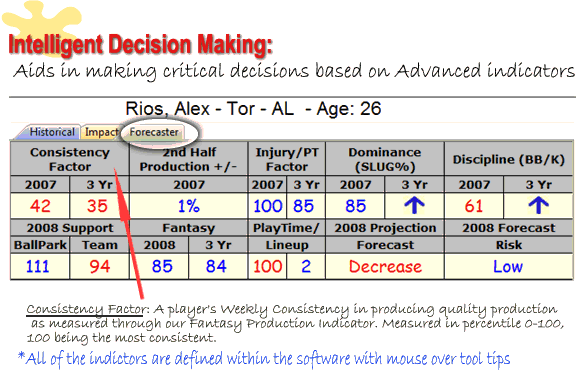Here's an update on an indicator we developed last season:
Consistency Factor: an indicator designed to measure a player's Weekly and/or Daily quality production output using Fantistics Fantasy Production Indicator (FPI).
For anyone who has played in a Head to Head league, you probably already know the importance of Weekly Consistency in player production. Similar in nature to the popular indicator which measures a pitcher's Quality Starts (Bill James), Consistency Factor gives us an indicator of a batter's quality games or quality weekly output. As a benchmark we are comparing each hitter's daily/weekly production to the average production of the top 250 major league hitters. If a player's production for a particular day or week is above the group mean, then the player registers a quality game/week. These games/weeks are accumulated and the sum is the output we're calling Consistency Factor.
|
|
|||||
| Player Name | Tm | Weekly '07 | % | 2-3 YR% | |
| 1 | Magglio Ordonez | Det | 22 | 84% | 67% |
| 2 | Hanley Ramirez | Fla | 21 | 82% | 78% |
| 3 | David Ortiz | Bos | 19 | 77% | 78% |
| 4 | Chipper Jones | Atl | 17 | 76% | 83% |
| 5 | Matt Holliday | Col | 20 | 76% | 73% |
| 6 | David Wright | NYN | 20 | 75% | 62% |
| 7 | Todd Helton | Col | 19 | 74% | 66% |
| 8 | Carlos Pena | TB | 18 | 73% | 66% |
| 9 | Alex Rodriguez | NYA | 19 | 72% | 65% |
| 10 | Albert Pujols | StL | 19 | 72% | 77% |
| 11 | Derrek Lee | ChN | 18 | 72% | 77% |
| 12 | Dave Roberts | SF | 13 | 68% | 61% |
| 13 | Chone Figgins | LAA | 13 | 68% | 58% |
| 14 | Ryan Howard | Phi | 16 | 67% | 75% |
| 15 | Jeff Kent | LAN | 15 | 66% | 69% |
| 16 | Reggie Willits | LAA | 15 | 66% | 76% |
| 17 | Rickie Weeks | Mil | 13 | 66% | 58% |
| 18 | Derek Jeter | NYA | 17 | 65% | 68% |
| 19 | B.J. Upton | TB | 14 | 65% | 60% |
| 20 | Jim Thome | ChA | 14 | 65% | 62% |
| 21 | Curtis Granderson | Det | 17 | 65% | 57% |
| 22 | Corey Hart | Mil | 15 | 64% | 66% |
| 23 | Placido Polanco | Det | 15 | 63% | 54% |
| 24 | Mike Jacobs | Fla | 12 | 63% | 58% |
| 25 | Jimmy Rollins | Phi | 17 | 63% | 55% |
| 26 | Carlos Lee | Hou | 17 | 63% | 59% |
| 27 | Carl Crawford | TB | 15 | 63% | 61% |
| 28 | Alfonso Soriano | ChN | 14 | 62% | 62% |
| 29 | Luis Castillo | NYN | 14 | 62% | 59% |
| 30 | David Eckstein | Tor | 11 | 62% | 42% |
| 31 | Dmitri Young | Was | 14 | 62% | 54% |
| 32 | Michael Young | Tex | 16 | 62% | 59% |
| 33 | Garrett Atkins | Col | 16 | 61% | 58% |
| 34 | Brandon Phillips | Cin | 16 | 61% | 58% |
| 35 | Eric Byrnes | Ari | 16 | 60% | 48% |
| 36 | Vladimir Guerrero | LAA | 15 | 60% | 68% |
| 37 | Carlos Guillen | Det | 15 | 60% | 69% |
| 38 | Johnny Damon | NYA | 14 | 60% | 57% |
| 39 | Shane Victorino | Phi | 13 | 60% | 47% |
| 40 | Jason Varitek | Bos | 13 | 60% | 54% |
| 41 | Grady Sizemore | Cle | 16 | 59% | 57% |
| 42 | Aramis Ramirez | ChN | 13 | 59% | 55% |
| 43 | Gary Sheffield | Det | 13 | 59% | 63% |
| 44 | Manny Ramirez | Bos | 13 | 59% | 65% |
| 45 | Mike Lowell | Bos | 15 | 58% | 46% |
| 46 | Carlos Beltran | NYN | 14 | 58% | 66% |
| 47 | Jorge Posada | NYA | 14 | 58% | 54% |
| 48 | Sammy Sosa | N/A | 11 | 58% | 46% |
| 49 | Kazuo Matsui | Hou | 10 | 58% | 53% |
| 50 | Brian Roberts | Bal | 15 | 58% | 57% |
The purpose of this indicator is to allow us to easily recognize those hitters who produce on a consistent basis and those that do not. For those who play in a weekly head to head format, the value of this indicator is obvious. In this segment, I am making a case for Consistency Factor as a relevant indicator for all fantasy or rotisserie league formats.
My premise here is simple: established players who do not produce quality output on a consistent basis are a risk to achieve similar success in the future. Essentially we want players who produce consistently rather than in sporadic episodes. The reasoning is a derivative of the laws of probability, consistency is paramount to lowering our risk...the more observations the better.
Consistency by it own summation will cost us on draft day, as a consistently productive player will logically produce the best stats overall. Thus the real value of the Consistency Factor is to: 1. find or exclude the players who are not consistent in their production and 2. target young players who are showing consistent patterns. There are a distinct group of players that mask their yearly results based on a few hot weeks of production. As a fantasy GM in a non weekly or head to head format format, you might be saying: "SO WHAT...as long as he produces what is expected in his final year end statistics".
Here is the reasoning why I am suggesting that inconsistent players be avoided: Streaky players, for the most part, will never be consistent players. Thus placing faith in a player who only produces in small time frames exposes his fantasy GM to injury and playing time risks that are beyond the normal scope.
Injury Risk Consideration
It's simple, stay away from players who are both inconsistent and injury prone. The premise: consistent players will produce evenly throughout the season and will not be as adversely affected by missing playing time. Their opportunities for achievement are more spread out, which reduces their risk.
Playing Time Risk Consideration
A perfect example of a player who produces in streaks is Milwaukee's Geoff Jenkins. Coming into 2006, Jenkins was the model of inconsistency for a player who usually ended the season with decent yet unspectacular numbers. A 27 HR/90 RBI/.290 BA were numbers most typical of his year end production. Yet Jenkins only had 10 out of 26 weeks of quality production in 2004, and 11 out of 26 weeks in 2005. Most players in this final stats range usually have about 15 quality weeks of production. Jenkins was getting by with 40%+ less consistency. In 2006 however, Jenkins hit such a long streaks of non production, he was essentially benched before he ever had a chance to reach his typical hot spurt.
How to properly use Consistency Factor
These are only two examples highlighting the risk in taking established players who are not consistent in spacing their production evenly throughout the season. Again I want to point out that this is just a premise based on my understanding of human behavioral patterns and the laws of probability. In thumbing through a list of consistent players and inconsistent players over the last 3 years, in most cases inconsistent weekly players (despite masking some years with quality year end numbers) have had more instances of disappointing seasons. To use this tool properly we need to compare apples to apples. Comparing Albert Pujols' consistency factor to that of Geoff Jenkins doesn't aid us in any manner, as Pujols is a much more valuable player and this will not come as a surprise to anyone in your draft either.
Here's the example we used last year:
As an example of comparing similar commodities, two players who had similarities in value heading into the 2007 draft are Vernon Wells and Bobby Abreu. Here's what they did in 2006:
Abreu: 98 R/15 HR/107 RBI/.297 BA/30 SB
Wells: 91 R/32 HR/106 RBI/.303 BA/17 SB
Wells HR totals are offset almost evenly to Abreu's SB totals. I've seen these players valued as almost interchangeable and their ADP (Average Draft Position - included in our projections software) shows that Abreu on average is being taken 7 spots ahead of Wells. I believe this gap should be wider. Consider that Wells produced above average results in 12 of his 26 playing weeks last year (38 percentile), while Abreu produced above average production in 17 of his 26 weeks (83 percentile). Sure their production was similar last year, but Abreu has produced on a more consistent basis which is inline with his 3 year average (91 percentile), while Wells is only in the 52 percentile over the last 3 years. This inconsistency brings to light his 2005 and 2004 campaigns when he averaged .270 and 80 Runs scored (part of which can be blamed on his poor OBA these years).
My Bottom line: Without any other factors to consider, and based on these consistency indicators, I would much rather ride with Abreu this year than I would with Wells.
I'm not ready to say that my call here, was exactly as expected. Although Wells went on and had a very poor year, one forecast is definitely not sound empirical evidence. However looking back there were many players who performed well the prior year without a favorable consistency factor only to reverse fate the following year...and this number was larger than those who followed up with a second strong season. Of the top 75 fantasy producers in 2006, the following 18 did it with a consistency of less than 50% (13 weeks or less). These include Rafael Furcal, Miguel Tejada, Michael Young, Gary Matthews Jr, Paul Konerko, Juan Pierre, Raul Ibanez, Todd Helton, Adam Dunn, Brian Giles, Nick Swisher, Kevin Youkilis, Bill Hall, Brian Roberts, Troy Glaus, Richie Sexson, Orlando Cabrera, & Orlando Hudson.
Of these 18, only 6 improved on their previous season (Juan Pierre, Todd Helton, Adam Dunn, Kevin Youkilis, Brian Roberts, Orlando Cabrera). 12 did not. The importance of playing the percentages can not be overstated, and when you can favorably swing the percentages to the tune of 2/1....you've got a solid indicator.
Players that I'm weary about heading into 2008 include: Torii Hunter, Jeff Francour, Brad Hawpe, Raul Ibanez, Adrian Beltre, Aaron Rowand, Mike Lowell, Edgar Renteria, Olando Cabrera, Khalil Greene, Coco Crisp, and Gary Matthews. All of these players have struggled in the past to maintain consistency.
Over the next few weeks we're going to post some player lists relating to consistency factors which should allow us to better understand it's impact as a forecasting aid on draft day.
If you have yet to register with us for the 2008 season, consistency factors are conveniently listed for each player in the Forecaster section of the projections screen (see below) and also are listed as a sort-able column as well.
Welcome Back,
Statistician and Publisher -Fantistics Insiderbaseball.com

































